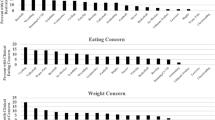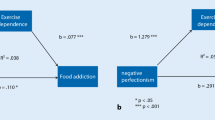Abstract
Purpose
This study investigated the associations between athletic and exercise identities and a range of disordered eating and exercise behaviors.
Method
Study 1 (N = 441; 53.5% female) included online questionnaires of athletic identity and disordered eating behaviors, anthropometrics, and demographic information. Study 2 (N = 225; 50.2% female) added measures of: exercise identity, exercise behaviors, and a broader measure of disordered eating behaviors. Multiple linear regressions were used to test hypotheses. Dominance analysis was used in Study 2 to determine the unique variance accounted for by each predictor.
Results
Controlling for body mass index (BMI), age, and sex, athletic identity was not significantly associated with disordered eating in Study 1 (ps > 0.039) but was significantly associated with lower cognitive restraint in Study 2 (p = 0.012). In Study 2, stronger exercise identity was significantly associated with more cognitive restraint (p < 0.001), more body dissatisfaction (p = 0.016), more compulsive exercise (p < 0.001), and more positive and healthy exercise (p < 0.001), after controlling for BMI, age, sex, and athletic identity. Dominance analyses suggested that exercise identity was more strongly associated with these outcomes than athletic identity.
Conclusion
Exercise identity, but not athletic identity, may be an important risk factor for disordered eating and exercise behaviors in broad populations.
Level of evidence
Level IV, results from uncontrolled trial.
Similar content being viewed by others
Data availability
The data that support the findings of this study are available from the corresponding author upon reasonable request.
References
Stein KF, Corte C (2008) The identity impairment model: a longitudinal study of self-schemas as predictors of disordered eating behaviors. Nurs Res 57(3):182. https://doi.org/10.1097/01.NNR.0000319494.21628.08
Erikson EH (1968) Identity: youth and crisis. vol 7. WW Norton & company
Zhan C, Heatherington L, Klingenberg B (2020) Disordered eating-and exercise-related behaviors and cognitions during the first year college transition. J Am Coll Health:1–12
Bulik CM, Kendler KS (2000) “I Am What I (Don’t) Eat”: establishing an identity independent of an eating disorder. Am J Psychiatry 157(11):1755–1760. https://doi.org/10.1176/appi.ajp.157.11.1755
Brewer BW, Van Raalte JL, Linder DE (1993) Athletic identity: Hercules' muscles or Achilles heel? Int J Sport Psychol
Taranis L, Meyer C (2011) Associations between specific components of compulsive exercise and eating-disordered cognitions and behaviors among young women. Int J Eat Disord 44(5):452–458
Gapin JI, Petruzzello SJ (2011) Athletic identity and disordered eating in obligatory and non-obligatory runners. J Sports Sci 29(10):1001–1010. https://doi.org/10.1080/02640414.2011.571275
Turton R, Goodwin H, Meyer C (2017) Athletic identity, compulsive exercise and eating psychopathology in long-distance runners. Eat Behav 26:129–132. https://doi.org/10.1016/j.eatbeh.2017.03.001
Anderson DF, Cychosz CM (1994) Development of an exercise identity scale. Percept Mot Skills 78(3):747–751. https://doi.org/10.1177/003151259407800313
Karr TM, Bauer KW, Graham DJ, Larson N, Neumark-Sztainer D (2014) Exercise Identity: Healthy and Unhealthy Outcomes in a Population-Based Study of Young Adults. J Sport Behav 37 (2)
Lantz CD, Rhea DJ, Mesnier K (2004) Eating attitudes, exercise identity, and body alienation in competitive ultramarathoners. Int J Sport Nutr Exerc Metab 14(4):406–418. https://doi.org/10.1123/ijsnem.14.4.406
Voelker DK, Gould D, Reel JJ (2014) Prevalence and correlates of disordered eating in female figure skaters. Psychol Sport Exerc 15(6):696–704. https://doi.org/10.1016/j.psychsport.2013.12.002
Voelker DK, Petrie TA, Reel JJ, Gould D (2018) Frequency and psychosocial correlates of eating disorder symptomatology in male figure skaters. J Appl Sport Psychol 30(1):119–126. https://doi.org/10.1080/10413200.2017.1325416
Ahlich E, Choquette EM, Rancourt D (2018) Body talk, athletic identity, and eating disorder symptoms in men. Psychol Men Masculinity. https://doi.org/10.1037/men0000168
Limburg K, Bodill K, Watson HJ, Kane RT, Hagger MS, Egan SJ (2019) Validity of the compulsive exercise test in regular exercisers. Eating Disorders:1–16
Palermo M, Rancourt D (2019) An identity mis-match? The impact of self-reported competition level on the association between athletic identity and disordered eating behaviors. Eating Behav. https://doi.org/10.1016/j.eatbeh.2019.101341
Meade AW, Craig SB (2012) Identifying careless responses in survey data. Psychol Methods 17(3):437
Cieslak TJ (2004) Describing and measuring the athletic identity construct: scale development and validation. The Ohio State University
Brewer BW, Cornelius AE (2001) Norms and factorial invariance of the athletic identity measurement scale. Acad Athletic J 15(2):103–113
Fairburn CG, Beglin S (2008) Eating disorder examination questionnaire. Cognitive behaviour therapy and eating disorders
DiBartolo PM, Shaffer C (2002) A comparison of female college athletes and nonathletes: eating disorder symptomatology and psychological well-being. J Sport Exercise Psychol 24(1):33–41. https://doi.org/10.1123/jsep.24.1.33
Gaines SA, Burnett TBS (2014) Perceptions of eating behaviors, body image, and social pressures in female division II college athletes and non-athletes. J Sport Behav 37(4):351
Hausenblas HA, Downs DS (2001) Comparison of body image between athletes and nonathletes: a meta-analytic review. J Appl Sport Psychol 13(3):323–339. https://doi.org/10.1080/104132001753144437
Ntoumanis N, Stenling A, Thøgersen-Ntoumani C, Vlachopoulos S, Lindwall M, Gucciardi DF, Tsakonitis C (2018) Longitudinal associations between exercise identity and exercise motivation: a multilevel growth curve model approach. Scand J Med Sci Sports 28(2):746–753. https://doi.org/10.1111/sms.12951
Forbush KT, Wildes JE, Pollack LO, Dunbar D, Luo J, Patterson K, Petruzzi L, Pollpeter M, Miller H, Stone A (2013) Development and validation of the Eating Pathology Symptoms Inventory (EPSI). Psychol Assess 25(3):859. https://doi.org/10.1037/a0032639
Danielsen M, Bjørnelv S, Rø Ø (2015) Validation of the exercise and eating disorders questionnaire. Int J Eat Disord 48(7):983–993. https://doi.org/10.1002/eat.22393
Faul F, Erdfelder E, Buchner A, Lang A-G (2009) Statistical power analyses using G* Power 3.1: tests for correlation and regression analyses. Behav Res Methods 41(4):1149–1160
Budescu DV (1993) Dominance analysis: a new approach to the problem of relative importance of predictors in multiple regression. Psychol Bull 114(3):542
Wilson PM, Muon S (2008) Psychometric properties of the exercise identity scale in a university sample. Int J Sport Exercise Psychol 6(2):115–131. https://doi.org/10.1080/1612197X.2008.9671857
Stryker S, Burke PJ (2000) The past, present, and future of an identity theory. Social Psychol Quarterly. https://doi.org/10.2307/2695840
Goodwin H, Haycraft E, Meyer C (2016) Disordered eating, compulsive exercise, and sport participation in a UK adolescent sample. Eur Eating Disorders Rev 24(4):304–309
Tasiemski T, Kennedy P, Gardner BP, Blaikley RA (2004) Athletic identity and sports participation in people with spinal cord injury. Adapted Phys Activity Quarterly 21(4):364–378
Tušak M, Kandare M, Bednarik J (2005) Is athletic identity an important motivator. Int J Sport Psychol 36(1):39–49
Bratland-Sanda S, Sundgot-Borgen J (2013) Eating disorders in athletes: overview of prevalence, risk factors and recommendations for prevention and treatment. Eur J Sport Sci 13(5):499–508. https://doi.org/10.1080/17461391.2012.740504
Funding
Not applicable.
Author information
Authors and Affiliations
Corresponding author
Ethics declarations
Conflict of interest
The authors declare that they have no conflict of interest.
Additional information
Publisher's Note
Springer Nature remains neutral with regard to jurisdictional claims in published maps and institutional affiliations.
Rights and permissions
About this article
Cite this article
Palermo, M., Rancourt, D. Understanding athletic and exercise identity in relation to disordered eating behaviors. Eat Weight Disord 26, 2301–2308 (2021). https://doi.org/10.1007/s40519-020-01092-2
Received:
Accepted:
Published:
Issue Date:
DOI: https://doi.org/10.1007/s40519-020-01092-2




